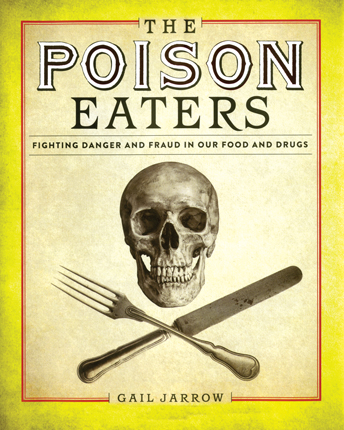| Poison eaters : fighting danger and fraud in our food and drugs Author: Jarrow, Gail | ||
| Price: $23.28 | ||
Summary:
The true story of how food was made safer to eat thanks to the stubborn dedication of government chemist Dr. Harvey Washington Wiley.
| Accelerated Reader Information: Interest Level: MG Reading Level: 7.70 Points: 4.0 Quiz: 505739 |
Reviews:
Kirkus Reviews (+) (08/01/19)
School Library Journal (11/01/19)
Booklist (+) (09/01/19)
The Bulletin of the Center for Children's Books (+) (00/10/19)
The Hornbook (00/01/20)
Full Text Reviews:
Booklist - 09/01/2019 *Starred Review* Beneath a skull-and-crossed-utensils cover, Jarrow (Spooked!, 2018) unleashes the Poison Squad as part of her fascinating, stomach-churning account of Harvey Washington Wiley’s crusade for food safety standards and regulation in the U.S. She opens with a fictional dinner scene in 1890, where she unmasks the true ingredients of a meal that realistically could have been served at the time. Sausage, canned peas, and cake sound wholesome enough, but that sausage was actually “made from a pulverized mass of meat scraps swept off the floor—along with the rat feces—and mixed with borax to keep it from rotting.” It’s enough to make you reach for a soothing elixir, but Wiley also debunked patent medicines. Trained in medicine and chemistry, Wiley was passionate about understanding the effects of altered or enhanced food products and medicines on human consumers. As the chief chemist of the U.S. Department of Agriculture’s Chemistry Division, he spearheaded the pure-food movement, which fought for a law to keep food and medicine safe and to require ingredient labels. Vintage ads, product labels, newspaper headlines, cartoons, and photographs offer a visual feast for readers, who will be so engrossed in the stories of unconscionable products and unwitting victims that they won’t realize they’re imbibing a powerful lesson in food safety and the evolution of today’s FDA. Extensive source notes and resources are icing on the cake. - Copyright 2019 Booklist.
School Library Journal - 11/01/2019 Gr 5 Up—Candy made with arsenic, babies soothed by morphine, and milk preserved with formaldehyde. After hooking readers with these gut-wrenching accounts, Jarrow focuses on Harvey Wiley, whose tireless efforts during the early 20th century heavily contributed to the first food and drug regulations in the United States. His food additive experiments on 12 men nicknamed the Poison Squad rose to national attention. While people were learning of the dangers they were ingesting, the government resisted regulations that would hurt its relationship with big business. But after Upton Sinclair's novel The Jungle was published, the government was swayed and the Food and Drugs Act of 1906 was born. The book recounts Wiley's attempts to effect change through his government work and as a writer for Good Housekeeping, up until the end of his life. Jarrow then briefly discusses current food regulation. Examples of contaminated foods and toxic medications will awe readers, and photos and graphics depict the horrors. VERDICT With detailed descriptions of revolting food-production standards and dangerously uncontrolled medications, Jarrow captivates readers with a history of food and drug regulation. Recommended for nonfiction readers and anyone interested in what they are eating.—Katherine Rao, Palos Verdes Library District, CA - Copyright 2019 Publishers Weekly, Library Journal and/or School Library Journal used with permission.




